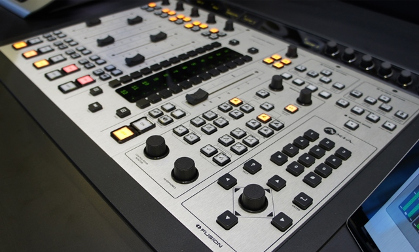It’s Time for Audio Over IP
Audio over IP (AoIP) continues to gain traction with TV broadcast and production facilities for many good reasons: it reduces overall costs, improves workflows, minimizes equipment needs and greatly simplifies and reduces infrastructure. Additionally, AoIP solutions leverage the Internet of Things (IoT) by seamlessly accommodating most commercial off-the-shelf (COTS) products for fast and easy integration, enabling a gradual introduction of islands of AoIP on an as-needed or budgeted basis. All of these greatly increase the overall cost efficiencies of AoIP solutions with significant cost-savings that can be realized when broadcast and business operations are integrated onto a single AoIP platform.

Axia Fusion AoIP mixing console
Another significant advantage of AoIP is that it supports enterprise-level solutions. Since most broadcast and production facilities have already been converted from analog to digital, and employ internal networks, it makes sense for their next step to be the transition of audio to IP. This applies to the broad base of critical operations across TV broadcast and production facilities, including: distributed and decentralized routing; mixer hardware and software; site-to-site connectivity; multiple-line call management; signal distribution and format conversion; real-time audio processing; audio measurement and monitoring; and IP intercom and communication.
Before implementing an AoIP solution however, it is most important to understand the technology and a little of its history to better evaluate the equipment and interoperability protocols available from different manufacturers.
AUDIO TRANSMISSION EVOLUTION
The classic analog studio takes much of its inheritance from the telecommunications industry when only two-way point-to-point audio was possible. The move to digital and the adoption of early standards such as AES3 allowed for audio transmissions to be synchronized within the studio environment and capabilities were later enhanced with a matrix, which enabled more channels and more control. This configuration was replaced by audio over Ethernet for network audio inside the studio and was then followed up by audio on an IP network, allowing audio to move in and out of the studio environment. The next iteration with a centralized server room allowed a distributed architecture for supporting geographically separated locations.
One driving force behind the transition from an analog structure to an IP audio network is reduced costs. Broadcast and production studios can achieve overall reductions with a common transport mechanism for audio, control, messaging and other data traffic such as files and email and VoIP phones. Even more savings are realized through faster installations because baseband to AoIP interfaces (such as Telos Alliance xNodes) can be conveniently placed near the equipment they serve; CAT 5e or 6 cabling can be used to the Ethernet switch and configuration is done using a PC and browser.
The professional video industry's #1 source for news, trends and product and tech information. Sign up below.
STANDARDS-BASED
These benefits provided a concrete value proposition for vendors to develop and market a variety of AoIP protocols. The current AES67 protocol, issued in 2013, ensures the interoperability of the various AoIP protocols available in the marketplace and was rapidly adopted by all major broadcast audio equipment vendors. Today, the most current and yet most mature AoIP protocol is Livewire+ AES67, which is ideally suited for all levels of TV broadcast and production workflow. This latest version picks up where AES67 leaves off by increasing system capacity and reducing costs, among other advantages.
With Livewire+ AES67, all connections including audio, logic, metadata and backfeeds are made using a single IP connection. The full interconnectivity via IP includes linear, low-latency audio, GPIO (General Purpose Input/Output), discovery of audio streams and more sophisticated control and monitoring protocols for instant routing at the destinations. Livewire+ AES67 leverages standard, off-the-shelf Ethernet switches to route audio and one switch can handle thousands of channels. The packets and streams are fully compatible with other IP traffic, so a single cable can carry real-time uncompressed digital audio, device control messages, program-associated data and even routine network traffic including email, file transfers and web browsing.
Livewire+ AES67 is based on a set of communication standards including STP (Scheduled Transfer Protocol) and UDP (User Datagram Protocol), QoS (Quality of Service) and IGMP (Internet Group Management Protocol), among others. STP and UDP are used to provide fast, efficient transmission over the network, while QoS is used to ensure the overall performance of the service (making sure high priority data gets sent first) and IGMP is used to establish multicast groups. In short, by using the right set of well-established networking standards, Livewire+ AES67 assures broadcast users highly reliable and low-latency delivery of audio streams.
HOW IT WORKS
AoIP is intended to run exclusively on a controlled local network infrastructure. It replaces much of the dedicated broadcast infrastructure such as routers, distribution and patching systems that have traditionally been used for managing multiple audio signals as they pass through a production or broadcast facility.
Audio sources are connected to an audio I/O device and the baseband to AoIP interfaces convert the audio to uncompressed, 24-bit/48 kHz digital audio and then packetize the audio into RTP streams. Each audio source is given a channel number and each interface is assigned an IP address for identification and routing purposes. The interfaces are networked to each other over a standard Ethernet IP network.
FUTURE PROOF
AoIP environments can easily adapt to any audio channelization format as well as accommodating control-data channels alongside the audio payload. The packet switching and serial design of Livewire+ AES67 allows greater flexibility and responsiveness in accommodating future changes in I/O configurations if needed. And IP audio networks provide broadcasters the flexibility to grow and change at will. Network capacity can be extended simply by adding more switches.
Finally, when choosing an AoIP protocol, it’s also important to carefully look at the feature set and user interfaces of the gear. Have some of your on-air people examine the control surfaces and talk through what’s on their wish list to see what capabilities they need right away and what they may want down the road. Drill down on specific pain points or throw out new scenarios—like handling phone calls or having a producer in a different room. Having a highly configurable system, and one that picks up where AES67 leaves off, will allow you and your team to make clever solutions.
John Shur is president of the Telos Alliance TV Solutions Group.
